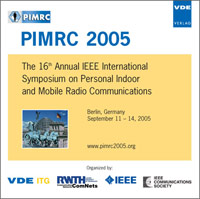Unified Signalling Using SIP in a B3G System
Conference: PIMRC 2005 - 16th Annual IEEE International Symposium on Personal Indoor and Mobile Radio Communications
09/11/2005 - 09/14/2005 at Berlin, Germany
Proceedings: PIMRC 2005
Pages: 5Language: englishTyp: PDF
Personal VDE Members are entitled to a 10% discount on this title
Authors:
Lioudakis, Georgios V.; Nikas, Vaggelis; Dellas, Nikos (Ericsson Hellas, 40.2 Km Attica road, 19002 Peania Municipality, Athens, Greece)
Pollak, Christoph; Wisenöcker, Richard (Siemens AG Österreich, Autokaderstraße 29, A-1210, Vienna, Austria)
Venieris, Iakovos S. (National Technical University of Athens, 9 Heroon Polytechniou str., 15773 Athens, Greece)
Abstract:
The adoption of packet-switched technologies in mobile communication systems has enabled the provision of IP-based services to mobile users. Yet, these systems, such as the UMTS network, are unable to meet the stringent delay requirements imposed by the enhanced multimedia services due to the anchor point that introduce into the user’s data path. Moreover, such applications will rely on IP-based control protocols for session and mobility management, resulting in duplication of functionality in the network at both the bearer and the application level. For the above reasons, the SAILOR network architecture is presented in this paper, proposing an evolution to the standard UMTS network, where GSNs are integrated into a single entity. Furthermore, the SIP protocol is adopted, for performing mobility and session management procedures currently undertaken by the UMTS Non-Access Stratum protocols. Both modifications to the UMTS network and protocol architecture, result in the smooth evolution of the UMTS core network towards IP as well as accomplish a significant performance gain.


